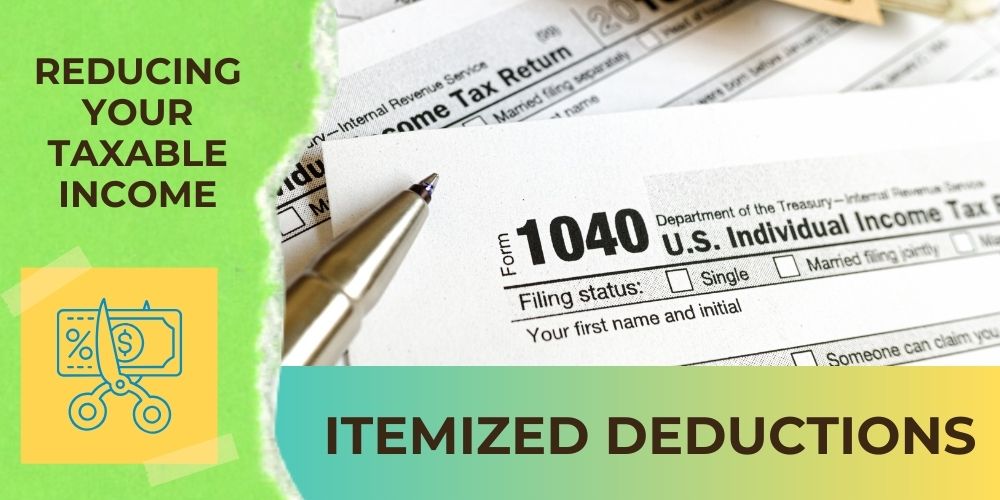How to choose standard deduction or itemized deductions?

Reducing your taxable income is a goal that everyone shares and one way to achieve it is by claiming either the standard deduction or itemized deductions. Understanding which one to choose will empower you to pay less taxes. In 2017, many laws changed that affect itemized deductions. Let’s get you caught up so that you can save up!
Once you’ve calculated your itemized deductions, the decision is simple. You just choose the largest number. It will create the largest deduction and therefore reduce your taxable income.
Standard Deduction > Itemized Deductions = Use Standard Deduction
How to calculate your itemized deductions?
Calculating your itemized deductions can be arduous. We recommend that you start with a very rough calculation and only dive into a more precise calculation when the results merit the effort. In other words, start with a jot on a post-it note before graduating to a spreadsheet. Since 2017, 90% of taxpayers are finding that they can stop their calculation at the post-it note. It is uncommon for itemized deductions to be larger than the standard deduction.
On your post-it note, write these 5 categories 1) Medical/Dental, 2) Local Taxes, 3) Interest, 4) Donations, 5) Disasters. List roughly how much money you spent on each one during the calendar year. Below are some details to help you brainstorm:
1) Typical medical and dental expenses include payments for prescription medications, acupuncturists, chiropractors, eye doctors, occupational therapists, physical therapists, psychiatrists, psychologists, lab services, eyeglasses, contact lenses, hearing aids, braces, wheelchairs, crutches, programs to stop smoking and possibly insurance premiums for medical and dental coverage. Do not include any of these expenses if they were paid by (or reimbursed by) your employer or insurer or with an HSA or FSA.
Common limitations: Before you dive into your pool of receipts, you should know that you can only deduct the amount of medical and dental expenses exceeding 7.5% of your adjusted gross income (line 11 of form 1040). For example, if your adjusted gross income is $100k.The first $7,500 of medical and dental expenses are not deductible. If you paid a total of $8k, only $500 would be deductible here.
2) Typical local tax expenses include taxes paid on the value of your home, vehicles, boats, RV’s, ATV’s, etc. If you pay city or state income taxes, they may be deductible here too. In lieu of city or state income taxes, you could deduct general sales tax amounts that are determined by the IRS. Use this online questionnaire from the IRS to calculate your potential sales tax deduction. It is based on your filing status, large purchases, income and number of dependents.
Common limitations: In general, the total local tax that you can deduct is limited to $10k for a couple that is married filing jointly. This limitation was new in 2017 and upset many residents of high tax areas like New York City or California where it is common to pay much more than $10k in local taxes.
3) Typical interest expenses include either a home mortgage loan or a student education loan.
Common limitations: The interest paid on your home mortgage loan only counts as a deduction if you used the loan to buy, build or substantially improve your home. In other words, if you’ve mortgaged your home to fund a sabbatical from work, the interest is not deductible here. Also, interest is only deductible for the first $750k of your home loan. For example, if your home loan is for $1million, only 75% of your interest expense is deductible. This prevents mansion dwellers from getting a gigantic deduction here. The deductible interest on your student loan is typically limited to $2,500. Refer to IRS Publication 970 to ensure that your student loan meets all requirements.
4) Typical charitable contributions are donations of cash and tangible items. Noone can deduct the value of their donated time or services but they may be able to deduct out-of-pocket expenses incurred while volunteering.
Common limitations: You can only deduct donations that are made to qualified charitable organizations. Use this online search tool from the IRS to find out if your favorite non-profit organization qualifies. Also, you must receive a written acknowledgement letter from the organization for any donations > $250. There are many other limitations on charitable contributions. Before making a donation, talk with your accountant and structure the transaction to create the largest tax deduction. After all, the money that you can save on taxes now could be part of your next donation!
5) Disasters create casualty and theft losses each year. The government must announce a “federally declared disaster” in order for taxpayers to deduct related losses on their tax return. This deduction is meant to provide tax relief helping survivors recover more quickly. Use this online search tool to view the list of federally declared disasters. In 2023 alone, there were 114 federally declared disasters.
Common limitations: You can only deduct the amount of casualty or theft loss exceeding 10% of your adjusted gross income (line 11 of form 1040). It is assumed that losses < 10% can be recovered without tax relief. For example, if your adjusted gross income is $100k.The first $10k of losses are not deductible. If you incurred a loss of $13k, only $3k would be deductible.
How to determine the standard deduction?
The standard deduction amount is adjusted annually for inflation by the IRS. It is usually printed on the first page of form 1040 or in the first pages of the IRS instructions for form 1040. For 2023’s tax returns, the standard deduction amounts are:
● $27,700 for married filing jointly taxpayers
● $20,800 for a head of household taxpayer
● $13,850 for a single or married filing separately taxpayer
Is it more common to take the standard deduction?
Yes, individuals tend to pay less taxes by taking the standard deduction instead of itemizing deductions. The goal of the standard deduction has always been to make tax filings less burdensome. Based on this research from the Tax Policy Center, most individual tax returns use the standard deduction. Before 2017, 70% of individual tax returns used the standard deduction. After 2017, the percentage increased to 90%. To recap, the most current research from the Tax Policy Center shows that only 10% of taxpayers see a benefit from itemizing deductions.
Another big perk about using the standard deduction is that you do not have to retain any supporting documentation for it. To the contrary, any itemized expenses must be supported by detailed receipts and schedules that show the calculations.
Why did the standard deduction change so much in 2017?
The Tax Cuts and Jobs Act of 2017 pretty much doubled the standard deduction amount. It did this by changing the index used for calculating the annual inflation increase from CPI-U to C-CPI-U. This change created the largest increase that we’ve ever seen for the standard deduction. For context, when the standard deduction was introduced in 1944, it was limited to $1,000. In 1970, the amount began to be increased annually for inflation. Before 2017, the largest increase of the standard deduction was in Ronald Reagan’s 1986 Tax Reform Act that increased it from $3,600 to $5,000 for joint filers.
How can you increase your itemized deductions?
Some taxpayers increase their itemized deductions by “bunching” them into every other year. For example, instead of donating $10k to charity each year, donate $20k every other year. In the year that you make the $20k donation, claim itemized deductions. In the year that you skip making a donation, claim the standard deduction. This strategy requires some planning. We recommend that you discuss it with your accountant to make sure
that your effort doesn’t get derailed by limitations, finer details in the current tax laws or ever-changing tax laws.
What changes are on the horizon?
Many of the significant changes from 2017’s Tax Cuts and Jobs Act will expire in 2025. Congress may vote to continue them or to change them entirely. Frequently changing tax laws can be frustrating for us all. One reason that tax laws are temporary is because they affect government income so budgetary rules have to be applied too. This article by the Tax Policy Center estimates that “making the individual income tax provisions of the Tax Cuts and Jobs Act permanent would cost about $3 trillion over one decade”.
The ever-changing tax laws are why it is important to work with an accountant that is educated on them and knows how to apply them to your personal circumstances to legally reduce your tax bill.
Ease Your Tax Decisions with Expertise
When it’s time to choose between standard deduction or itemizing, Colvin CPA is here to ensure you make the best decision for your finances. We’re committed to keeping up with tax law changes, providing you with custom advice to secure all your eligible savings.
Want to make tax time less taxing? Let Colvin CPA be your guide. Our expert team is ready to streamline your tax filing and enhance your benefits. Say goodbye to tax season stress and hello to confidence. Contact us now for peace of mind and a more rewarding tax experience.
Have a related topic you’d like to learn more about? Share it with us, so we can add it to our blog!


